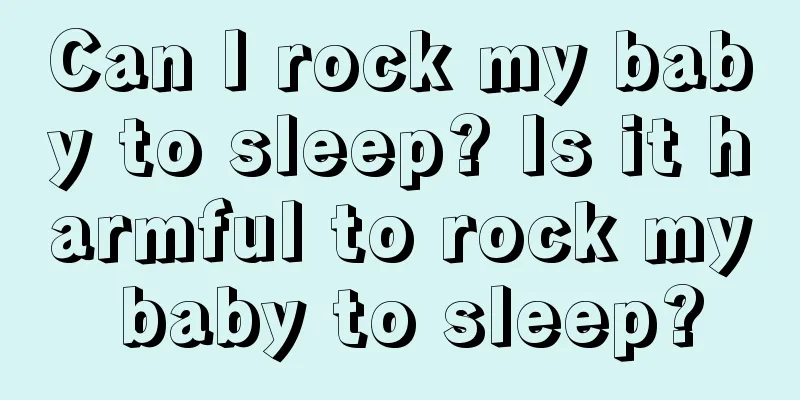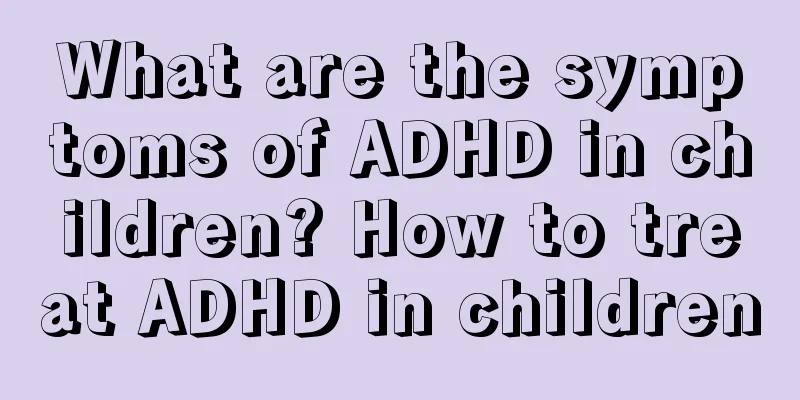Can I rock my baby to sleep? Is it harmful to rock my baby to sleep?

|
The problem of baby sleeping has always been a difficult problem for new parents. When babies are young, they cannot understand what their parents say. What should parents do to coax their babies to sleep correctly? Let's talk about whether you can use the rocking method to coax babies to sleep. Is it okay to rock your baby to sleep?Do you know that shaking your baby may cause "shaken syndrome"? Because newborns have relatively large heads, soft bones, and no self-protective movements, violent shaking can create a huge impact force in the baby's brain, posing a health hazard to the baby. When parents are coaxing their babies to sleep, they should avoid violently shaking or lifting their babies. So, since rocking a baby to sleep is bad for health, can you hold the baby to sleep? For babies, holding the baby to sleep will not only make the baby's sleep shallow, but also make the body curled up in the mother's arms, unable to stretch freely, and the muscles of the whole body cannot get rest, thus affecting the quality of sleep; holding the baby to sleep for a long time will make the baby develop a bad habit of not sleeping without holding, affecting the normal physical development. For mothers, if they often hold the newborn to sleep, it will seriously affect the normal rest, drag down the mother's spirit, and is not conducive to the recovery of the body. Dangers of shaking your babyThe action of shaking the baby is not only used when coaxing the baby to sleep, but also when playing with the baby. Do you know that there are many hidden dangers in this shaking? 1. The neck is vulnerable to injury. Shaking a baby can easily damage the muscles and ligaments in their neck, and in severe cases, it can even sprain the baby's neck. This is because the baby's bones are not yet fully developed, and the bones are relatively soft. The head accounts for nearly half of the body weight, and the weight is supported by the muscles and ligaments of the neck. The gap in the subarachnoid space of the baby's brain is large, the neck muscles are weak, the ligaments are less elastic, and the cervical spine is not completely ossified, making it difficult to withstand large-scale shaking and high-throw shocks. When being shaken, it is easy to get injured. 2. It causes temporary congestion of the brain. The baby's brain is still in the early stages of development. Some parents throw their babies high up, which will cause the blood in the baby's body to impact the brain from time to time, which will cause temporary congestion of the brain. If you keep shaking the baby, or throw the baby up and catch the baby again and again, it is easy for the brain tissue in the baby's head to collide with the harder head due to shaking or high throwing, causing brain damage. In this case, the baby may refuse to drink milk, be drowsy or easily get angry. In severe cases, there may be symptoms of increased intracranial pressure such as sudden coma, difficulty breathing, and projectile vomiting. 3. Cause local anemia. When being shaken, the baby is like an adult playing a high-speed amusement ride. The baby's body cannot withstand the huge centrifugal force, and the blood flows to one side, which can easily cause local anemia. The baby will become pale, have difficulty breathing, stand unsteadily, and even faint, vomit, etc. In severe cases, it may cause a significant decline in the baby's intelligence, severe movement disorders, blindness, and substantial brain damage, such as brain atrophy, brain softening, brain cysts, etc. Will there be any problem?Expert explanation: It is possible, but the probability is extremely low Experts say shaking a baby too much can cause a bloody mass on the brain, a condition known as "cradle in the womb syndrome." Experts explained that the brain of infants under 18 months old is not fully developed. Their brain is like soft tofu placed in the skull, and there is no connection between the brain tissue and the skull. If the child's brain tissue develops slower than the skull, a cavity will appear between the two. At this time, when the child is shaken for a long time at a certain frequency, it will cause subdural effusion. Once the cavity and effusion appear, the child continues to be shaken, the brain will also vibrate, the veins between the skull and the brain will be squeezed, and blood flow will be blocked, which will cause "minor concussion syndrome", chronic subdural effusion or chronic subdural hematoma. In more serious cases, blindness or even death may occur. However, in fact, the incidence of "cradle syndrome" is extremely low. So far, the hospital has not admitted a true "cradle syndrome" patient. Experts believe that children are precious nowadays, and "I'm afraid no parents would use such high-intensity and high-frequency force on their babies." The "children were shaken unconscious" and "rattle effect" mentioned in the Weibo post are extreme cases, which should be intended to remind young parents that shaking children is risky and they should pay more attention. |
<<: The pregnancy test shows that I am not pregnant, but I haven’t had my period. What’s going on?
Recommend
How long will the menstruation be delayed after taking the birth control pill? How long will it take for the menstruation to come after taking the birth control pill?
Although birth control pills are a convenient, fa...
What to do if your milk is too thin? What are the reasons for low milk supply?
Generally, mothers will breastfeed their children...
How to get your baby to speak as early as possible
The language development progress of each infant ...
What should I do if my baby catches a cold? Can a one-month-old baby take medicine for a cold?
Everyone must have had a cold in life, but do you...
Kindergarten breakfast recipes Kindergarten breakfast recipes
The school season is coming soon, and many babies...
Can I use a facial mask during confinement? What brand of facial mask is good for breastfeeding?
Applying facial masks has always been a very popu...
Is Johnson's shower gel acidic or alkaline? How is Johnson's shower gel?
My baby’s shower gel is finished and I plan to sw...
Can't eat salt during confinement? Eat salt in moderation
There are many taboos during the confinement peri...
Can pregnant women eat turkey? It has high nutritional value.
Pregnant women can eat turkey. The nutritional va...
How to treat menstrual pain, poor pregnancy, chocolate cysts
Women who are trying to get pregnant should not t...
The efficacy and function of Lengshenling toothpaste. Is Lengshenling toothpaste effective for tooth sensitivity?
I have always heard that Lengshenling toothpaste ...
What should I do if my child doesn't want to go to school during his rebellious period? What should I do if my child has a bad temper and is irritable during his rebellious period?
Usually, children will go through several stages ...
How long will it take for neonatal acne to heal? Can Bactroban be used for neonatal acne?
The baby has a lot of rashes on his face, which i...
How to add complementary food to babies with allergies? Mothers must pay attention to these points
You can start adding complementary foods to your ...
How to choose newborn pajamas? Pay attention to 6 key points
Newborn babies are very fragile, and they need to...









